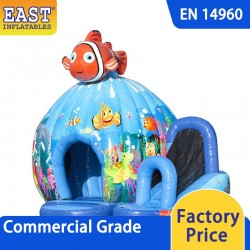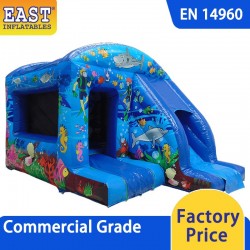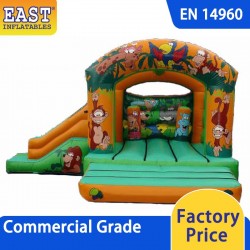
Inflatable castles, also known as bounce houses or inflatable play structures, have become incredibly popular at children's parties and events. They offer hours of fun and entertainment for kids, but one common question that often arises is whether these inflatable structures can be used safely in strong winds. In this article, we'll explore the factors that affect the use of inflatable castles in windy conditions.
Inflatable castles are typically designed to be used in fair weather conditions with mild to moderate winds. They are constructed from durable materials such as PVC and nylon, which can withstand normal wear and tear. However, when wind speeds exceed certain limits, inflatable castles can become unsafe.
The maximum safe wind speed for inflatable castles varies depending on the size and design of the structure. Smaller units designed for residential use may have a lower wind speed tolerance than larger commercial-grade inflatables. Manufacturers usually provide guidelines on safe wind speeds for their specific products, and it's essential to follow these recommendations to ensure safety.
Here are some factors to consider when using inflatable castles in windy conditions:
Wind Speed Limits: Always check the manufacturer's guidelines for the maximum wind speed rating of your inflatable castle. It's crucial to know this limit and avoid using the inflatable when wind speeds exceed it.
Anchoring: Properly securing the inflatable is crucial. Most inflatable castles come with anchor points or stakes that should be used to secure the structure firmly to the ground. Ensure that all anchor points are utilized to prevent the castle from being lifted by the wind.
Wind Gusts: Wind gusts can be stronger than sustained winds. Keep an eye on local weather conditions and be prepared to deflate and secure the inflatable if wind gusts become a concern.
Supervision: Regardless of the weather, it's essential to have adult supervision when children are playing on an inflatable castle. Supervisors can monitor wind conditions and take appropriate action if necessary.
Weather Forecast: Before setting up the inflatable, check the weather forecast for the day of your event. If high winds are predicted, it may be best to postpone or relocate the activity to a sheltered area.
Deflation: If wind speeds increase significantly while the inflatable is in use, it's essential to deflate and secure the structure promptly. Safety should always be the top priority.
In conclusion, while inflatable castles can provide hours of entertainment for children, they should only be used in appropriate weather conditions. Strong winds can pose a safety risk, so it's crucial to follow manufacturer guidelines, anchor the inflatable securely, and monitor wind conditions closely. By taking these precautions, you can ensure a safe and enjoyable experience for everyone at your event.




Leave a Comment